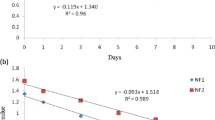Abstract
Dissipation of penconazole was estimated in tomatoes fruits cultivated in field using QuEChERS method for sample preparation and high performance liquid chromatography with diode array detector. Following one application of normal dose 25 mL 100 L−1 water, the average initial deposits of penconazole were observed to be 0.74 and 1.21 mg kg−1 for tomatoes fruits and soil, respectively. The residues dissipated below the maximum residues limit of 0.2 mg kg−1 after 15 days. The half-life value (T1/2) and preharvest interval of penconazole were 5.61 and 15 days, respectively. While (T1/2) of penconazole in soil was 15.51 days. Thus, a waiting period of 15 day was suggested for the safe consumption of penconazole treated Tomatoes.


Similar content being viewed by others
References
Abd-Alrahman SH, Almaz MM, Ahmed NS (2011a) Dissipation of fungicides, insecticides, and acaricide in tomato using HPLC-DAD and QuEChERS methodology. Food Anal Methods 5:564–570
Abd-Alrahman SH, Almaz MM, Osama IA (2011b) Determination of degradation rate of acaricide fenpyroximate in apple, citrus, and grape by HPLC-DAD. Food Anal Methods 5:306–311
Bromilow R, Evans A, Nicholls P (1999) Factors affecting degradation rates of five triazoles fungicides in two soil types: 2 field studies. Pest Manag Sci 55:1135–1142
Castillo-Sanchez J, Aguilera-Del Real A, Rodriguez-Sanchez M, Valverde-Garcia A (2000) Residue levels, decline curves, and plantation distribution of procymidone in green beans grown in greenhouse. J Agric Food Chem 48:2991–2994
EL-Nabarawy IM, Abou-Donia MA, Amra HA (1992) Determination of profenofos and malathion residues in fresh tomatoes and paste. Egypt J Appl Sci 7:106–111
Engindeniz S (2006) Economic analysis of agrochemical use for weed control in field-grown celery: a case study for Turkey. Crop Prot 27:377–384
Fenoll J, Ruiz E, Hellín P, Lacasa A, Flores P (2009) Dissipation rates of insecticides and fungicides in peppers grown in greenhouse and under cold storage conditions. Food Chem 113:727–732
Garrido Frenich A, Martinez Vidal JL, Pastor-Montoro E, Romero-Gonzalez R (2008) High-throughput determination of pesticide residues in food commodities by use of ultra-performance liquid chromatography-tandem mass spectrometry. Anal Bioanal Chem 390:947–959
Kim IS, Beaudette LA, Shim JH, Trevors JT, Suh YT (2002) Environmental fate of the triazole fungicide propiconazole in a rice-paddy-soil lysimeter. Plant Soil 239:321–331
Kim IS, Shim JH, Suh YT (2003) Laboratory studies on formation of bound residues and degradation of propiconazole in soils. Pest Manag Sci 59:324–330
Lehotay SJ (2007) Determination of pesticide residues in foods by acetonitrile extraction and partitioning with magnesium sulfate: collaborative study. J AOAC Int 90:485–520
Lehotay SJ, de Kok A, Hiemstra M, Van Bodegraven P (2005) Validation of a fast and easy method for the determination of residues from 229 pesticides in fruits and vegetables using gas and liquid chromatography and mass spectrometric detection. J AOAC Int 88:595–614
Paya P, Anastassiades M, Mack D, Sigalova I, Tasdelen B, Oliva J, Barba A (2007) Analysis of pesticide residues using the quick easy cheap effective rugged and safe (QuEChERS) pesticide multiresidue method in combination with gas and liquid chromatography and tandem mass spectrometric detection. Anal Bioanal Chem 389:1697–1714
Pose-Juan E, Rial-Otero R, Lopez-Periago JE (2010) Sorption of penconazole applied as a commercial water-oil emulsion in soils devoted to vineyards. J Hazard Mater 182:136–143
Singh N, Dureja P (2009) Effect of biocompost-amendment on degradation of triazoles fungicides in soil. Bull Environ Contam Toxicol 82:120–123
Thorestensen C, Lode O (2001) Laboratory degradation studies of bentazone, dichlorprop, MCPA and propiconazole in Norwegian soils. J Environ Qual 30:947–953
World-Compendium (2000) The pesticide manual. british crop protection council, 12th ed, Tomlin CDS, Farnham, Surrey, UK pp 67–68
Acknowledgments
The project was supported by the Research Center, College of Science, King Saud University.
Author information
Authors and Affiliations
Corresponding author
Rights and permissions
About this article
Cite this article
Abd-Alrahman, S.H., Ahmed, N.S. Dissipation of Penconazole in Tomatoes and Soil. Bull Environ Contam Toxicol 89, 873–876 (2012). https://doi.org/10.1007/s00128-012-0776-7
Received:
Accepted:
Published:
Issue Date:
DOI: https://doi.org/10.1007/s00128-012-0776-7




